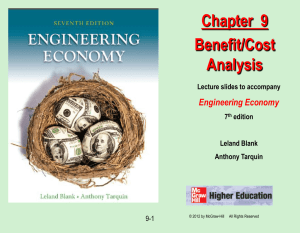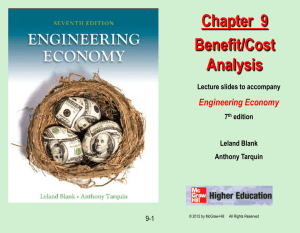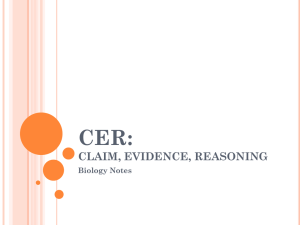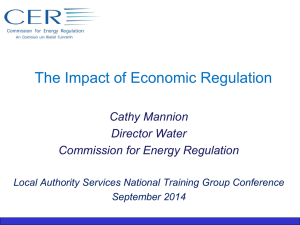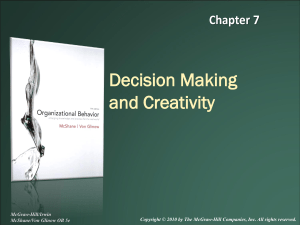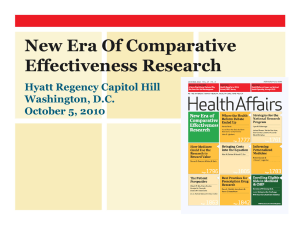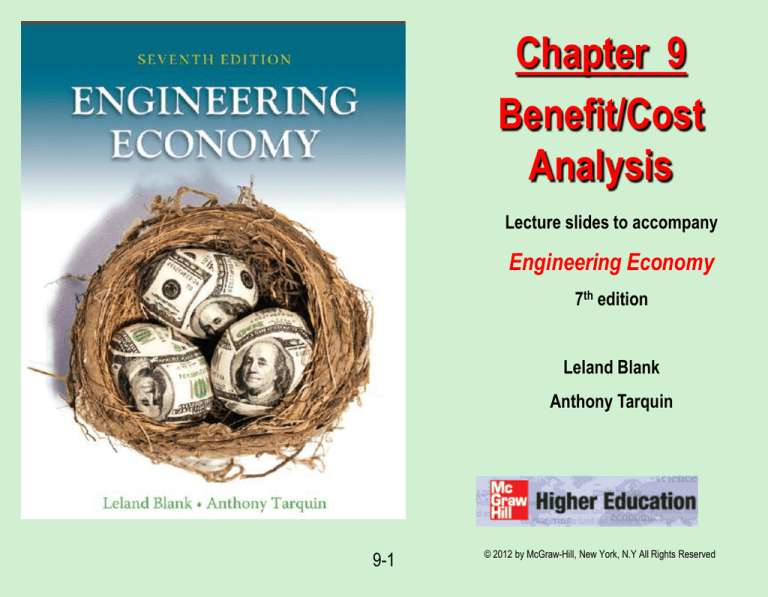
Chapter 9
Benefit/Cost
Analysis
Lecture slides to accompany
Engineering Economy
7th edition
Leland Blank
Anthony Tarquin
9-1
© 2012 by McGraw-Hill, New York, N.Y All Rights Reserved
LEARNING OUTCOMES
1. Explain difference in public vs private sector projects
2. Calculate B/C ratio for single project
3. Select better of two alternatives using B/C method
4. Select best of multiple alternatives using B/C method
5. Use cost-effectiveness analysis to evaluate projects
6. Describe how ethical compromises may enter public
sector projects
9-2
© 2012 by McGraw-Hill, New York, N.Y All Rights Reserved
Differences: Public vs Private Projects
Characteristic
Public
Size of Investment
Large
Life
Annual CF
Funding
Interest rate
Selection criteria
Private
Small, medium, large
Longer (30 - 50+ years)
No profit
Shorter (2 – 25 years)
Profit
Taxes, fees, bonds, etc. Stocks, bonds, loans, etc.
Lower
Higher
Multiple criteria
Primarily ROR
Environment of evaluation Politically inclined
9-3
Economic
© 2012 by McGraw-Hill, New York, N.Y All Rights Reserved
Cash Flow Classifications in B/C Analysis
Must identify cash flows as either benefits, disbenefits, or costs
Benefits(B)--Advantages to the public
Disbenefts (D)--Disadvantages to the public
Costs (C)--Expenditures by the government
Note: Savings to government are subtracted from costs
Conventional B/C ratio = (B – D)/C
Modified B/C ratio = [(B – D) – C]/ Initial Investment
Profitability Index = NCF/ Initial Investment
Note 1: All terms must be expressed in same units (i.e. PW, AW, or FW)
Note 2: Do not use minus sign ahead of costs
9-4
© 2012 by McGraw-Hill, New York, N.Y All Rights Reserved
B/C Analysis – Single Project
Conventional B/C ratio =
B-D
C
Modified B/C ratio = B – D – M&O
C
If B/C ≥ 1,
accept project;
otherwise, reject
Denominator is
initial investment
PI = PW of NCFt
PW of initial invest
9-5
© 2012 by McGraw-Hill, New York, N.Y All Rights Reserved
Example B/C Analysis – Single Project
A flood control project will have a first cost of $1.4 million with an annual
maintenance cost of $40,000 and a 10 year life. Reduced flood damage is
expected to amount to $175,000 per year. Lost income to farmers is estimated
to be $25,000 per year. At an interest rate of 6% per year, should the
project be undertaken?
Solution: Express all values as A and then find B/C ratio:
B = $175,000
D = $25,000
C = 1,400,000(A/P,6%,10) + $40,000 = $230,218
B/C = (175,000 – 25,000)/230,218
= 0.65
<1.0
Do not build project
9-6
© 2012 by McGraw-Hill, New York, N.Y All Rights Reserved
Alternative Selection Using Incremental B/C
Analysis – Two or more Alternatives
Procedure similar to ROR analysis for multiple alternatives
(1)
(2)
(3)
(4)
(5)
(6)
(7)
Determine equivalent total cost for each alternative
Order alternatives by increasing total cost
Identify B & D for each alternative, if given, or go to step 5
Calculate B/C for each alternative and eliminate all with B/C<1.0
Determine incremental costs and benefits for first two alternatives
Calculate ∆B/C; If >1.0, higher cost alternative becomes defender
Repeat steps 5 & 6 until only one alternative remains
9-7
© 2012 by McGraw-Hill, New York, N.Y All Rights Reserved
Cost Effectiveness Analysis
Service sector projects primarily involve intangibles, not
physical facilities; examples include health care, security
programs, credit card services, etc.
Cost-effectiveness analysis (CEA) combines monetary cost
estimates with non-monetary benefits estimates to get
cost-effectiveness ratio (CER)
CER = equivalent total costs/effectiveness measure
= C/E
9-8
© 2012 by McGraw-Hill, New York, N.Y All Rights Reserved
CER - Independent Projects
Procedure is as follows:
(1) Determine total cost & effectiveness measure and calculate CER
(2) Order projects: smallest to largest CER
(3) Determine cumulative cost of projects and compare to budget, b
(4) Fund all projects such that b is not exceeded.
From the CERs shown below, determine which independent
programs should be selected if the budget limit is $500,000.
Program
A
B
C
D
CER, $/graduate
1203
752
2010
1830
Program Cost, $
305,000
98,000
126,000
365,000
9-9
© 2012 by McGraw-Hill, New York, N.Y All Rights Reserved
CER - Independent Projects Cont’d
First, Rank programs according to increasing CER:
Program
B
A
D
C
CER, $/graduate
752
1203
1830
2010
Program Cost, $
98,000
305,000
365,000
126,000
Next, select programs until budget is not exceeded:
Select programs B and A at total cost of $403,000
9-10
© 2012 by McGraw-Hill, New York, N.Y All Rights Reserved
CER – Mutually Exclusive Projects
Procedure is as follows:
(1) Order alternatives smallest to largest effectiveness measure, E
(2) Calculate CER for first alternative, the defender
(3) Calculate incremental cost (∆C) & incremental effectiveness (∆E)
and incremental measure (∆C/ (∆E) for challenger
(4) If (∆C/ (∆E) < C/Edefender ,challenger becomes defender; otherwise, no
dominance is present and both alternatives are retained
(5) If dominance was present in step (4), eliminate defender and compare
next alternative to new defender per steps (3) and (4). If dominance not
present, current challenger becomes new defender against next challenger,
but old defender is still viable.
(6) Continue steps (3) through (5) until only 1 alt or non-dominated alts remain
(7) Apply budget limit (or other criteria) to determine which of remaining
non-dominated alternatives can be funded
9-11
© 2012 by McGraw-Hill, New York, N.Y All Rights Reserved
CER – Mutually Exclusive Projects
From the cost and effectiveness values shown below, determine which
mutually exclusive alternative should be selected.
Program
A
B
C
Cost (C)
$/person
2200
1400
6860
Effectiveness (E)
wins/person
4
2
7
9-12
CER
$/win
550
700
980
© 2012 by McGraw-Hill, New York, N.Y All Rights Reserved
CER – ME Projects Cont’d
Solution:
Order programs according to increasing effectiveness measure, E:
Program
B
A
C
Cost (C)
$/person
1400
2200
6860
Effectiveness (E)
wins/person
2
4
7
B vs DN: C/EB = 1400/2 = 700
A vs B: ∆C/E = (2200 – 1400)/(4 – 2) = 400
C vs A: ∆C/E = (6860 – 2200)/(7 – 4) = 1553
CER
$/win
700
550
980
eliminate B
no dominance.
Must use other criteria to select either A or C
9-13
© 2012 by McGraw-Hill, New York, N.Y All Rights Reserved
Ethical Considerations
Engineers are routinely involved in two areas
where ethics may be compromised:
Public policy making – development of strategy
Public planning - development of projects
Engineers must maintain integrity and impartiality and
always adhere to code of ethics
9-14
© 2012 by McGraw-Hill, New York, N.Y All Rights Reserved
Summary of Important Points
B/C method used in public sector project evaluation
Can use PW, AW, or FW, but must be consistent with units for B,C, and D
For multiple mutually exclusive alternatives, compare two at a time
and eliminate alternatives until only one remains
For independent alternatives, compare each against DN and select
all that have B/C ≥ 1.0
CEA analysis combines cost and nonmonetary measures
Ethical considerations are especially prevalent in public sector projects
9-15
© 2012 by McGraw-Hill, New York, N.Y All Rights Reserved

